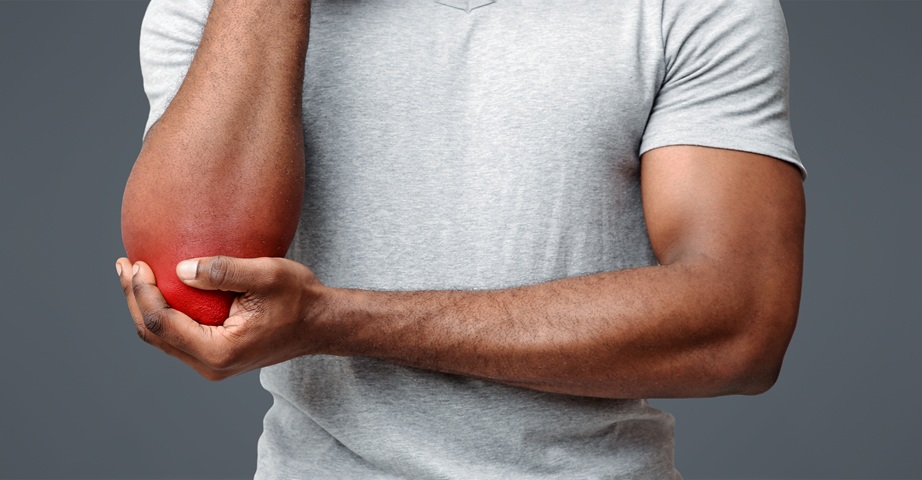Tennis Elbow - what is it? Symptoms, causes, and treatment

Tennis elbow is a condition characterized by pain on the outer side of the elbow joint, often leading to limited mobility of the upper limb. It develops due to microtraumas caused by repetitive, systematic movements, affecting not only athletes but also office workers, painters, and others who perform similar motions.
Tennis elbow symptoms - what are the typical signs of elbow joint pain? What exercises can help with tennis elbow? How is tennis elbow treated?
Table of contents
- What is tennis elbow?
- Where does tennis elbow hurt?
- Tennis elbow - causes
- Risk factors - who is at risk?
- Symptoms of tennis elbow
- How can I tell if I have tennis elbow?
- What to do about tennis elbow? Recommended treatment
- Home remedies for tennis elbow
- Tennis Elbow - Rehabilitation, Exercises, and Treatments
- Exercises for tennis elbow
- Invasive methods when there’s no improvement
- Tennis elbow - how long does treatment take?
- Untreated tennis elbow - what are the consequences?
- Summary - how to deal with tennis elbow?
What is tennis elbow?
Tennis elbow, also known as lateral epicondylitis of the humerus or lateral elbow pain syndrome, is a degenerative condition affecting the tendon attachments caused by overuse of the elbow joint. It is a soft tissue pain syndrome most commonly linked to overload injuries in the tendons of the wrist extensor muscles.
This condition develops from repetitive microtraumas leading to overload changes. It is characterized by pain in the elbow joint that can radiate down the forearm to the wrist, often accompanied by circulatory issues that slow down healing.
Where does tennis elbow hurt?
People with lateral epicondylitis feel pain on the outer side of the elbow, where the forearm muscle tendons attach to the bony bump on the side of the elbow. This pain can be sharp, burning, or dull and may spread to the wrist, making everyday tasks difficult to perform.
Tennis elbow - causes
Pain in the lateral compartment of the elbow joint is referred to as tennis elbow because the condition is often observed among players who focus on this sport, especially among beginners or amateur tennis players who have not yet developed the correct technique for performing movements while playing the sport.
In addition, tennis elbow and unwanted pain in the elbow joint may also be caused by:
- excessive strain on the muscles and tendons responsible for straightening the wrist;
- microtrauma caused by repetitive movements of the wrist and hand in dorsiflexion, e.g. when working at a computer or painting;
- prolonged maintenance of the wrist in a flexed position;
- incorrect biomechanics of movement.
Risk factors - who is at risk?
Repetitive, monotonous movements can increase the risk of developing tennis elbow, making certain groups more prone to overuse-related elbow pain. People particularly at risk include:
- office workers
- plumbers
- hairdressers
- IT specialists
- painters
- sculptors
- tailors
- dentists
- electricians
Forearm pain is also common among professional cleaners, who often keep their wrists bent and press their hands against surfaces, further increasing the chance of developing the condition.

Symptoms of tennis elbow
Tennis elbow primarily causes pain on the outside of the elbow joint, which may worsen during certain movements such as turning the forearm, straightening the elbow, or extending the wrist. Pain can also occur when clenching the fist, straightening the fingers, or twisting the forearm outward.
Severe pain from tennis elbow can limit the elbow’s range of motion, making everyday tasks and household chores difficult. It may even prevent you from grasping and lifting objects, like a cup of tea, while increasing tenderness in the affected tissues. Additionally, tennis elbow can lead to muscle weakness and swelling around the elbow joint.
How can I tell if I have tennis elbow?
If you suspect you have lateral epicondylitis of the humerus, it’s a good idea to start by visiting your primary care physician. They may then refer you to a sports medicine specialist, orthopedic surgeon, or physical therapist for further evaluation.
Tennis elbow is usually diagnosed through palpation and a detailed interview about your symptoms. Specific tests that involve positioning the arm and applying resistance, pressure, or certain movements can help confirm the diagnosis.
The most commonly used tests to diagnose tennis elbow are:
- Cozen’s test
- Mill’s test
- Thompson’s test
- Maudsley’s test
In some cases, an ultrasound of the elbow joint is performed to pinpoint the exact source of pain and assess the extent of tendon damage. Occasionally, an MRI may also be ordered for a more detailed evaluation.
What to do about tennis elbow? Recommended treatment
Treatment for tennis elbow mainly focuses on rest and allowing the damaged tissue to heal. It’s also important to address the cause of the microtraumas. However, since changing jobs or retraining may not be possible immediately, temporarily limiting wrist movement can help relieve pain on the outside of the elbow joint.
Early intervention can speed up recovery, helping you return to full fitness and making daily tasks easier. Therefore, when experiencing symptoms, it’s crucial to use home remedies for tennis elbow alongside following the advice and treatment plans recommended by specialists, including exercises and, if necessary, invasive procedures.
Home remedies for tennis elbow
Home remedies that may help ease pain and discomfort from tennis elbow include resting the elbow and avoiding activities that worsen the pain. Applying ice packs and gently massaging the painful area can be very effective. Additionally, cabbage compresses or using pain-relieving and anti-inflammatory ointments may provide relief.
Over-the-counter painkillers can be used as directed, and wearing bands, braces, or stabilizers can help reduce strain on the muscle attachments, promoting relaxation of the injured tissues.
Dietary supplements supporting joints, muscles, and tendons can also aid recovery by providing essential nutrients to the damaged structures. Among the recommended options, OstroVit dietary supplements are worth considering, such as:
- OstroVit Marine Collagen 200 g, which contains hydrolyzed fish collagen peptides, supporting the reconstruction of collagen fibers in the human body and having a beneficial effect on the strength of joint cartilage;
- OstroVit Pharma Flex Aid 60 capsules - a comprehensive, 10-ingredient dietary supplement that supports the proper functioning of joint cartilage and can have a positive effect on, among other things, the range of motion in the joints;
- OstroVit Flex Regen 400 g - a comprehensive preparation containing 12 valuable substances that can support bones, joints, and tendons, facilitating their optimal functioning.

Tennis Elbow - Rehabilitation, Exercises, and Treatments
Rehabilitation can be a valuable support for those suffering from tennis elbow. What treatments are worth considering?
For people with the condition, as well as those at risk of developing it, regularly practicing stretching and strengthening exercises for the forearm muscles is recommended.
In addition to exercises, massage or kinesiotaping can help reduce muscle tension and relieve pain. Another effective treatment is ESWT (shock wave therapy), a painless method that uses high-pressure acoustic waves generated by a special device to penetrate several centimeters deep into the tissue, easing pain symptoms.
In some cases, specialists may also suggest injections with platelet-rich plasma or corticosteroids to support healing and reduce inflammation.
Exercises for tennis elbow
Strengthening the forearm muscles and stretching the tendons around the elbow can help relieve pain in the lateral condyle of the humerus. Stretching the fingers, extending the arms, and bending and straightening the wrist are beneficial. Here are some helpful exercises:
- Sit down and bend your arm at the elbow. Rest your forearm on a table and hold a small weight in your hand, such as a dumbbell or a 0.5-liter water bottle. Slowly lower your hand by bending your wrist, then return to the starting position. Repeat with the other arm.
- Sit down and raise your arm to shoulder height. Keep your elbow straight and use your other hand to gently stretch the extensor muscles by bending your wrist further. Hold this stretch for 20 seconds, then slowly return to the starting position.
Invasive methods when there’s no improvement
While home remedies combined with the right exercises and treatments are usually effective in easing tennis elbow symptoms, there are cases when non-invasive methods don’t deliver the desired results. In such situations, invasive treatment may be needed, often involving arthroscopic surgery.
Arthroscopy helps remove fibrosis and osteophytes from the tissue and supports the reconstruction of damaged structures. This procedure can reduce pain and improve joint mobility, positively affecting the patient’s daily life.
Tennis elbow - how long does treatment take?
Treating tennis elbow is often a lengthy and repetitive process that can last from several weeks to several months, depending on factors like the severity of the injury, external conditions, and the patient’s individual healing ability.
Most people experiencing pain on the outer side of the elbow notice improvement within 6 to 12 months after beginning the recommended treatment. If you have elbow pain, it’s important to be patient and follow the guidance of your doctor or physical therapist.
Untreated tennis elbow - what are the consequences?
Ignoring pain in the elbow area and not taking appropriate action can lead to weakening of the wrist extensor muscles and, in some cases, permanent degeneration of the tendon tissue in the elbow.
Neglecting treatment may cause inflammation, resulting in chronic pain and limited mobility, which can hinder not only physical activity but also everyday tasks and basic functions. Untreated tennis elbow can also increase the risk of complications in the elbow joint and, in severe cases, may lead to disability of the upper limb.
However, some scientific studies suggest that symptoms of untreated tennis elbow may resolve spontaneously within 12 months from the onset of the first symptoms, and improvement of the elbow joint’s condition is possible even without surgical intervention recommended for lateral epicondylitis of the humerus.
Summary - how to deal with tennis elbow?
Tennis elbow affects not only athletes but also people whose work or daily activities involve repetitive movements. Managing this condition typically requires weeks or even months of dedicated therapy. Effective treatment combines home remedies - such as targeted exercises and dietary supplements with non-invasive therapies like transverse massage, kinesiotaping, and shock wave therapy.
Successful recovery demands commitment and perseverance, but these efforts can significantly accelerate healing, restore full arm function, and greatly improve quality of life and overall well-being.

